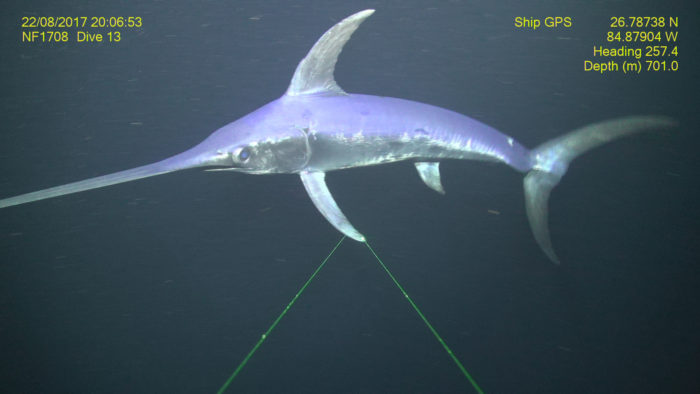
Sea Wonder: Swordfish

Photo credit: FWC Fish and Wildlife Research Institute
A species of billfish, swordfish are aptly named for their elongated, flat bills. They are some of the fastest fish on the planet and fierce predators. Interestingly enough, swordfish don’t use their bills like swords to impale their prey.
Description
Swordfish (Xiphias gladius) get their scientific name from the words for ‘sword’ in Greek and Latin, which is appropriate given their flat bill that resembles a long blade. They resemble other billfish species like marlin and sailfish, swordfish are the only members of the Xiphiidae family.
Swordfish have an elongated body and a long bill extending from its snout. The swordfish’s bill is longer than that of other billfishes and their bodies larger. The largest recorded swordfish were 14.9 feet long and 1,430 pounds! The average swordfish, though, is about 10 feet long, with females reaching larger sizes than males when fully grown. Swordfish are purplish to bluish in color on top of their bodies, silvery below, and have two dorsal fins and two anal fins. By the time they reach adulthood, swordfish lose all their teeth and scales. More than 50 types of parasites use swordfish as hosts, which experts can use to determine where in the ocean an individual swordfish spends most of its time.
Diet & Habitat
Swordfish are cold-blooded (ectothermic) animals but have specialized organs next to their eyes that provide warmth for their eyes and brains, which makes their vision sharper and their cognition stronger. This, in turn, makes them formidable predators for mackerel, hake, rockfish, herring, squid, and crustaceans. They are nocturnal hunters and use their bills to slash at their targets to stun and dismember them. Swordfish can reach speeds of 60 to 80 miles per hour when swimming at burst speeds, which makes them an intimidating and formidable predator. Adult swordfish have few predators of their own beyond humans and the occasional orca as a result. Juvenile swordfish are eaten more often by species like sharks, marlins, sailfishes, tuna, and mahi mahi.
Swordfish live in the open ocean along temperate and tropical latitudes in the Atlantic, Pacific, and Indian Ocean. They tend to stay in waters that are between 64- and 72-degrees Fahrenheit (18-22 Celsius) and have the widest temperature range tolerance of any billfish species. They migrate seasonally to follow prey, moving to warmer waters in the hemispheric winter months and to cooler waters in the summer. This highly migratory fish species is often found where ocean currents meet and productivity is high.
Life History
We don’t know much about the reproductive behavior of swordfish except that their spawning activities tend to occur in warmer waters all year long and during the hemispheric spring and summer months in cooler areas of the ocean. Females carry between one and 29 million eggs, which are fertilized externally during spawning. To reproduce, females release millions of buoyant eggs into the water column, where they are fertilized by clouds of sperm provided by male swordfish. Once fertilized, the eggs incubate for a few days to several weeks. Eggs that aren’t eaten or damaged lead to the hatching of tiny larval swordfish, which measure only 4 millimeters long with extremely tiny snouts.
As they transition from their larval to juvenile stage, swordfish bills grow quite quickly and start to resemble the sword-like bill we see in adults. In their first year, swordfish can grow quite rapidly to reach lengths of nearly three feet (one meter). As they grow, prickly scales that protect them from predators begin to shed and their bodies begin to narrow. The dorsal fin runs the length of the juvenile swordfish’s body, lengthening and separating as they grow. They reach sexual maturity when fully grown, which happens at about five to six years old. Data suggests their maximum lifespan is around nine years old.
Threats & Conservation
Fishing and other human activities are currently the most significant threats to swordfish populations worldwide. The size, strength, and speed of these large fish make them desirable sport fish due to the challenge it is to land one. Swordfish are also caught for commercial consumption as it is a popular menu item at restaurants worldwide, however, it tends to contain high levels of mercury in its tissues. They are most often caught using longline fishing techniques.
Atlantic populations of swordfish receive protections from regulations and collaborative efforts between governments, industries, and recreational fishers dedicated to helping populations recover and achieve sustainability. Climate change, ocean acidification, and marine pollution also pose current and future threats to swordfish species.

A swordfish spotted during the 2017 Southeast Deep Coral Initiative (SEDCI) expedition. Photo credit: NOAA Southeast Deep Coral Initiative and Pelagic Research Services.
